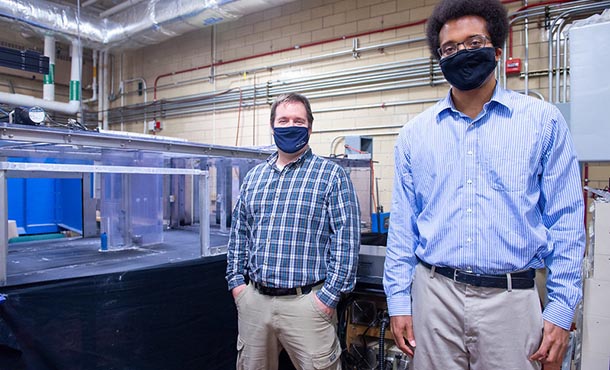
Stephen Lynch (left) and David Williams (right) plan to accelerate the designs of higher performing, more efficient and safer aircrafts for the United States Navy. IMAGE: TYLER HENDERSON
$541K Office of Naval Research grant could enhance aircraft performance
Mechanical engineering faculty to deeply probe the physics of freestream turbulence to allow for next generation designs of Navy aircrafts and other turbomachinery
1/12/2021
By Erin Cassidy Hendrick
UNIVERSITY PARK, Pa. — Researchers in the Penn State Department of Mechanical Engineering received $541,167 to accelerate the designs of higher performing, more efficient and safer aircraft for the United States Navy.
The grant, administered by the Office of Naval Research (ONR), will fund the exploration and improved understanding of the effects of freestream turbulence on tip vortex breakdown and decay mechanisms.
“As the Navy is trying to create more aggressive designs, they want to push the envelope to get every ounce of performance they can,” said David Williams, assistant professor of mechanical engineering and the principal investigator. “As those engineers are trying to improve airplane wings, inlets or turbomachinery applications, we want them to have a clearer understanding of what the effects of freestream turbulence could be.”
Freestream turbulence is a phenomenon that affects aircraft systems. For example, as an airplane flies, it creates a disturbance in the atmosphere. At the edge of the aircraft’s wings, the flow of air acts differently, creating a vortex that circles the wingtip which are often called wingtip vortices. A similar effect, tip vortices, can also be created over the broader surface of the wings with vortex generators or inside the inlets of aircraft engines. In everyday conditions, these tip vortices are fairly predictable and are taken into account in the design of the aircraft.
However, in unconventional situations, such as when a fighter jet takes flight from a ship navigating rough seas, the chaotic freestream turbulence can result in unstable and possibly dangerous tip vortices. Essentially, a lack of concrete understanding of this turbulence restricts military aircraft performance, forcing engineers to potentially overcompensate with conservative designs.
Through this project, the researchers aim to provide ONR with a more comprehensive picture of this effect — opening the door for higher performing and more fuel-efficient designs, including fighter jets and weapons systems.
“In addition to enabling safer operation, we want the Navy to be able to push the envelope a lot further,” Stephen Lynch, associate professor of mechanical engineering and the co-principal investigator, said. “If we find where the boundary exists on these conservative designs and show you can go up to this exact point, we can increase performance and maintain safety.”
The project will have two complementary components, computational simulations and physical experiments. The computational side, led by Williams, will leverage the power of Roar, the University’s supercomputer housed in the Institute for Computational and Data Sciences.
“When a lot of the current helicopters and airplanes were designed in the 80s or 90s, the computational power was lower,” Williams said. “In the modern era, using Roar and some Department of Defense supercomputers, we can go after some problems in a way that just couldn’t be done before.”
These resources will allow the team to simulate the entire range of freestream turbulence flows, from the largest scales to the smallest. To do so, Williams will use a high-order, wall-modeled, implicit large eddy simulation approach to solve the compressible Navier-Stokes equations.
“Once we have the results from the computational simulation, how will we know they are correct?” Williams said. “We’ll do that by comparing the results of the computations to the physical experiments to cross-check each other.”
They plan to test and validate the resulting models in Lynch’s experimental wind tunnel within the Experimental and Computational Convection Laboratory.
“These will be challenging experiments,” Lynch said. “These vortex breakdowns or bursts, they are very sensitive to the measurement device you are using. We can’t just stick a probe into the flow because it would influence the behavior.”
Lynch will use laser-based methods to gather data optically without disrupting the experiment. The power of combining these computational and experimental methods will allow the researchers to validate each other’s data and provide a fundamental understanding of the phenomenon.
“We will ground each other in terms of accuracy and make sure we are getting the physics right,” Lynch said.
While the researchers expect the project will pose significant challenges, they explained their newfound partnership will make the process enjoyable.
“Our shared enthusiasm for the project really came through in the proposal,” Williams said.
Lynch agreed, highlighting the importance of their drive to solve the problem at hand.
“We have the computational horsepower to solve these problems in the right way and we know the applications we want to evolve and the technology we want to impact,” he said.



